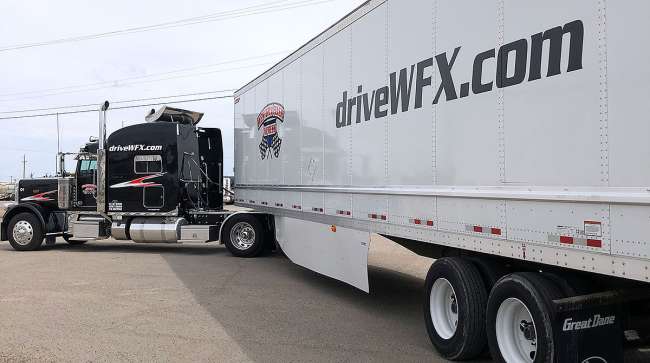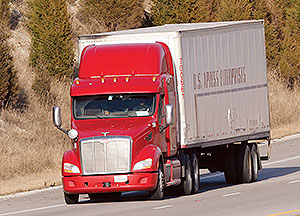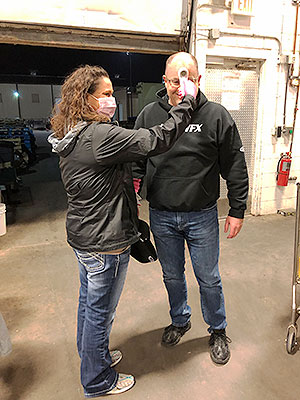Senior Reporter
For Some Fleets, Adding Drivers Is a Mission

[Stay on top of transportation news: Get TTNews in your inbox.]
The spread of the coronavirus has created some division in the freight-hauling sector.
As the situation at two fleets illustrated, while some loads have dwindled to a trickle in this temporarily locked-down economy, other parts of the trucking industry are booming to meet the demand for necessary consumer goods and medical supplies, and adding drivers however they can.
“I think lots of carriers are looking for experienced drivers, for the moment at least,” American Trucking Associations Chief Economist Bob Costello said.

U.S. Xpress truck by John Sommers II for Transport Topics
U.S. Xpress, with 6,900 tractors, announced it is seeking drivers with a minimum of three months’ experience.
“We are handling an increased volume from customers in the grocery and retail segments, and we’re looking to ensure we can maintain our fleet to meet that demand,” U.S. Xpress Chief Operating Officer Matt Herndon said.
Specifically, the company is looking to fill an unspecified number of seats in its over-the-road team and dedicated divisions, with Herndon saying the process was “open and rolling.”
Recently, the company received a call from someone wanting to bring 50-plus lease trucks over to it from the hard-hit oil patch, where oil prices have plummeted 67% since January, according to Bloomberg News.
“We see this as an opportunity to help and hire those who have been economically impacted or displaced as jobs are furloughed during this crisis,” Herndon said.
The company added new features to its in-cab technology to show an estimated 40,000 tractor-trailer parking locations and 36,000 grocery stores in the wake of restaurants being closed nationwide since the coronavirus spread.
U.S. Xpress Enterprises ranks No. 20 on the Transport Topics Top 100 list of the largest for-hire carriers in North America.
At Western Flyer Xpress, with a fleet of 1,000 trucks, CEO Randy Timms got behind the wheel to deliver loads of groceries in a dry van throughout rural Oklahoma, arriving at night or early morning in the towns of Buffalo, Shawnee and Thomas.
“An opportunity came up for us,” he said. “To a certain degree, I felt like time was of the essence. All hands on deck, and anybody that could help contribute should do that. I feel like this crisis put an emphasis on how critical trucking and, obviously, drivers are to the backbone of our economy.”
Timms said he saw the small grocery business is lot like trucking — family-owned businesses that don’t necessarily make a lot of money but work hard and are committed.

A warehouse worker checks Randy Timms' temperature. (Western Flyer Xpress)
“Grocery stores are open long hours. All these people were available 24/7 to unload these groceries from the trailer. And not just the people in the store, but the people that they knew would volunteer to come and help get the shelves restocked. Local people inside these small towns,” he said.
At the same time, some segments of the industry are completely shut down.
“If you haul auto parts, you’re not working right now. Or cars. We have seen a dramatic falloff in truckloads of tires, for example,” Timms said.
“If you don’t participate in sectors of transportation that handle essential items,” he added, “there’s a pretty good chance your volume of business has been greatly reduced.”
Western Flyer Xpress, based in Oklahoma City, offers local, regional, dedicated and over-the-road lanes to company drivers and contractors.
Meanwhile, the wheel is going to turn, said Ken Adamo, chief of analytics at DAT Solutions. Consumers stockpiling paper products and groceries, for example, can only do so for so long until there is a pullback in some of that volume.
“My team’s main focus is looking at when that inflection point is going to happen, how severe it is going to be and what the longer term impacts are going to be on the freight markets,” Adamo said. “I think you are going to see kind of a stall pattern soon, and then see volumes come back down.”
By then, capacity most likely will have increased, reflecting March’s surge in spot rates, especially for dry van loads.
“When rates spike up, part-time drivers and folks — who aren’t always in the market —with mothballed capacity enter,” Adamo said.
In the meantime, vital freight has to keep arriving, especially into hot spots.
When the Centers for Disease Control and Prevention issued the self-quarantining guidance for greater New York City residents leaving this area, it reported it was “out of an abundance of caution to help protect U.S. areas with lower levels of COVID-19 spread.”
It added this guidance does not apply to critical transportation and delivery workers “who are desperately needed for New York residents to continue their daily lives and respond to the COVID-19 outbreak.”
Want more news? Listen to today's daily briefing:




